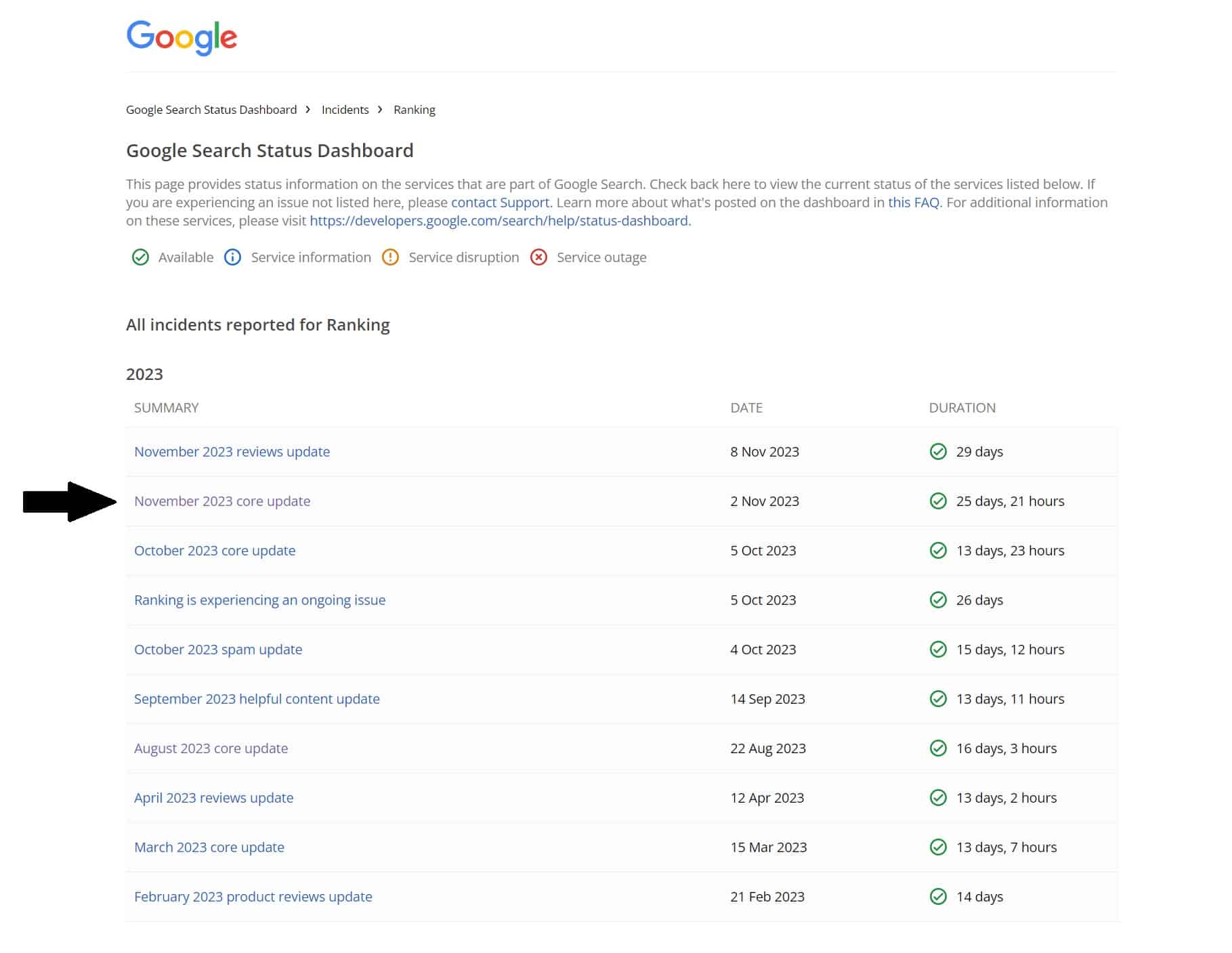
This week, we’re talking about Google’s November 2023 Core Update taking 26 days to complete. Is that a record? And what about website traffic? It’s a main success indicator, right? Structured data, separators in sitelinks, and so many more powerful topics in this week’s chat, you can’t afford to miss out.
November Core Update 26 Days Later
The November 2023 Core Update stands out as the longest Google Core Update in history, taking 26 days to fully roll out. Its timing, coinciding with the critical shopping season, added to the apprehension among SEOs and website owners. This period is traditionally focused on maximizing sales and online visibility, making the extended duration of the update particularly impactful.
Adding to the already vulnerable state of the situation, this Core Update overlapped with the November Reviews Update. This simultaneous rollout of two significant updates introduced additional complexity and uncertainty. Website owners and SEOs had to navigate changes from both updates, making it challenging to pinpoint the specific causes of fluctuations in search rankings and traffic.
Given the unpredictable nature of search algorithm updates, especially during critical business periods, flexibility and quick response are key.
Misconceptions About Traffic as a Success Metric
Google’s “Search Off the Record” podcast highlighted a common misconception in SEO — the overemphasis on traffic as a measure of success. SEOs and digital marketers often celebrate increased traffic as a triumph, but this perspective can be misleading. The real question is the impact of this traffic on sales or ad clicks. If there’s no positive change in earnings, the increase in traffic might not be as valuable. People are showing up, but no one is buying.
Google’s John Mueller and Martin Splitt discussed the importance of understanding the business impact of traffic. They emphasized the focus not on the traffic volume but on its value and return on investment (ROI). Mueller noted that many tend to overlook the ROI aspect, possibly due to the delayed effect of SEO efforts on business outcomes, and also pointed out that traffic metrics can be misleading (some of us knew this, but hang in there). They show what happened but not why it happened. For instance, ranking for irrelevant keywords might bring a lot of traffic, but this traffic is not beneficial for the site. It’s important to focus on relevant queries and track the performance of individual pages more closely.
When diagnosing traffic drops, especially those related to ranking changes, it’s important to also look at the impact on sales. If there’s no monetary impact, it might be necessary to redirect content and SEO efforts toward more profitable directions. This reinforces the importance of aligning strategies with business goals and prioritizing conversions and sales over traffic numbers.
Understanding the different types of traffic and their potential to convert into sales or leads and updating strategies to adapt to incoming data is vital. Knowing the rule book is different from playing the game, but being able to do both is your key to successful outcomes.
Overall, traffic is just one of the many metrics to consider. The ultimate goal should be to drive traffic that contributes to the business’s bottom line, whether through direct sales, lead generation, or brand building. Aim for traffic that positively impacts sales and overall business growth.
Structured Data for Enhanced Visibility
Google announces its support of structured data specifically for discussion forums and profile pages in Google Search. This update improves the identification and display of information from web forums and personal profiles in the SERPs.
Google is also launching a new Search Console report to monitor the implementation of this new structured data. The report will provide details on errors, warnings, and valid items detected on pages with the markup. Additionally, Google’s Rich Results Test tool now supports testing and validating these new markups.
Structured Data Types
- Profile Page Markup: This new structured data allows Google Search to better recognize key information about content creators, such as their name, social media handle, follower count, profile photo, and content popularity. It enhances the accuracy of creator profiles and metrics in search results.
- DiscussionForum Posting Markup: Designed for forums where users share personal perspectives and experiences, this markup helps Google Search better surface online discussions. It’s distinct from Q&A markup, which is recommended for forums structured around questions and answers.
Potential Benefits
- Improved Search Appearance: Correctly implementing structured data can make webpages more prominent in Google, potentially increasing click-through rates.
- Visibility for Individual Creators: This update may give individual content creators better chances of being highlighted in search results alongside larger publishers.
- Audience Growth Opportunities: The new markup allows Google to better identify content creators and their information, including links to social profiles, which could benefit those relying on their brand for visibility.
While implementing this structured data is voluntary, those who do may see improved visibility in Google’s search results. It’s clear that Google is putting effort into this, which leaves room to ‘read between the lines’ and make assumptions about the true value Google places on structured data.
Google’s 2023 Search Quality Rater Guidelines
The 2023 update to Google’s Search Quality Rater Guidelines places a renewed emphasis on user intent and the quality of search results, aligning closely with the principles of E-A-T (Expertise, Authoritativeness, Trustworthiness) and the Helpful Content Update. This shift reinforces Google’s commitment to refining search quality and providing content that is authoritative and trustworthy and directly addresses user queries.
The guidelines now instruct raters on evaluating the quality of forum and Q&A pages, reflecting the E-A-T principle. The focus is on the expertise and trustworthiness of content, including the quality of comments and discussions.
Key changes and improvements:
- User Location and Query Interpretation: Understanding user location in queries aligns with providing helpful, contextually relevant content, a core aspect of the Helpful Content Update.
- Clarifying ‘Minor Interpretations’ of Queries: The expanded definitions for interpreting queries support the goal of meeting specific user needs, ensuring content is relevant and useful.
- Defining ‘Know Simple’ and ‘Do’ Queries: Clarifying these query types helps raters and creators align content with user intent, a key aspect of E-A-T and creating helpful content.
- Refining User Intent and SERP Features: Classifying user intents and providing examples of SERP features that meet these needs align with creating content that is expertly tailored to user queries.
Watercooler Highlights
Google’s Experiment with Line Separators in Sitelinks
Google has been experimenting with a new design element in its search results: line separators between Sitelinks. This test significantly alters the visual presentation of Sitelinks in Google Search results, providing more screen space and a distinct separation for each snippet. This design test is part of Google’s ongoing efforts to enhance user experience by experimenting with different Sitelink interfaces. The addition of line separators aims to make the snippets more prominent and easier to navigate.
Google Ads’ New Guide on Value-Based Bidding
Google has introduced a new guide titled “Testing value-based bidding using Google Ads campaign experiments.” This four-page PDF document is valuable for those looking to test and implement Maximize Conversion Value or Target ROAS (Return on Ad Spend) bidding strategies.
The guide details the process of setting up value-based bidding experiments, choosing the right settings, monitoring and evaluating success, and scaling these experiments for broader applications. It emphasizes using campaign experiments as an effective method to test value-based bidding. These experiments allow for a clear comparison between the new value-based and current bid strategies, maintaining constant other variables for accurate impact measurement.
Ginny Marvin, the Google Ads Liaison, highlighted this guide as a crucial tool for advertisers aiming to optimize their bidding strategies for better conversion value or targeted ROAS.
Vulnerability in WordPress AMP Plugin Affects Over 100,000 Sites
The WordPress AMP plugin, installed on over 100,000 websites, recently patched a medium-severity cross-site scripting (XSS) vulnerability. The vulnerability was specifically related to the plugin’s use of shortcodes, a feature in WordPress that lets users embed plugin functionalities or content within posts and pages.
This vulnerability was identified and reported by Patchstack, a WordPress security company. They warned that such scripts could include redirects, advertisements, and other HTML payloads, which would activate when visitors access the site. The issue was resolved in version 1.0.89 of the plugin.
Wordfence, another security firm, also described the vulnerability, emphasizing that it required at least contributor-level permissions for exploitation. Rated as a medium severity level vulnerability, it scored 6.5 out of 10, with ten being the most severe. Users of the plugin are advised to update to the patched version to ensure their websites’ security.
With expertise in SEO strategies and a keen understanding of the latest updates, Plan Left can help you navigate the complexities of search engine optimization. Whether it’s optimizing your content or safeguarding your site against vulnerabilities, our knowledgeable team is equipped to effectively boost your online presence. Contact Plan Left today to elevate your SEO game and achieve your digital marketing goals.
Explore Latest Posts
5 Signs Your Business Is Ready to Own Its Marketing (Without an Agency) The default assumption in business is that ... read more
December 31, 2025
From Feast to Famine: How to Create Predictable Revenue in Your Business Three months ago, you couldn't take on another ... read more
December 29, 2025
Why Competing on Price Is Killing Your Margins (And What to Do Instead) When a prospect asks "how much do ... read more
December 25, 2025
Essential Strategies for Entrepreneurs
Get Actionable Business Insights & Marketing Tips
Our newsletter delivers real-world strategies from entrepreneurs who’ve been exactly where you are.
Sign up now for:
- Actionable growth strategies that work
- Insider tactics for attracting top talent
- Real-world case studies from successful founders
- Emerging tech trends that drive innovation
- Pragmatic marketing approaches for visionary leaders





